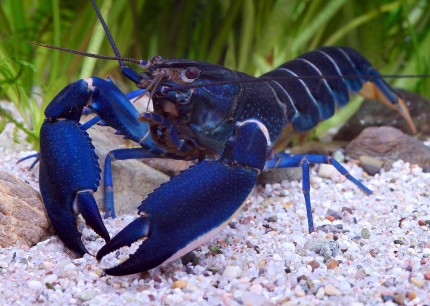In the genus Cherax from Australia and Papua / Indonesia as well as Papua New Guinea there are incredibly great colored species, including the only 2017 first described Cherax pulcher from the Vogelkop Peninsula on Papua with its blue pink color, the Black Scorpion Cherax holthuisi, the variant Chocolate Apricot Crab, Cherax holthuisi or the Apricot Crab, also Cherax holthuisi. Also the newly imported Blue Claw Tiger Crayfish Cherax peknyi "Blue Claw", which is a very attractive color variation of the Tiger Crayfish Cherax peknyi, belongs to the beautiful intensely colored Cherax crayfish from Papua. The Cherax Blue Kong also belongs to this species. Cherax communis, the Blue Papuan Crayfish, and the Fire Crayfish (Cherax snowden), also known as Orange Tip, are from Papua. There is also an orange variety of Cherax snowden, the Sunshine Apricot Crayfish. From Papua New Guinea comes the Lorentz' crayfish Cherax lorentzi, from Papua / Indonesia come the Red Papua crayfish as well as the Blue Papua crayfish, both color variants of Cherax boesemani. Also the Papua Crab Cherax cf. monticola belongs to the great, beautifully colored crayfishes from Irian Jaya / Papua. Still undetermined is the dark blue crayfish Cherax Blue Moon, but so much can be said that it is related to Cherax pulcher. Cherax warsamsonicus looks very similar to pulcher. It is known as Cherax Irian Jaya in the hobby. All these Cherax species need rather hard water and an aquarium with an edge length of at least 80-100 cm. As juveniles Cherax from Papua need rather animal food, but also foliage and vegetable food, as adults Papuan Cherax should hardly eat animal proteins, because the wrong food can cause severe moulting problems in them, which can even be fatal. Special vegetarian food is really important for them, but they also like to eat brown autumn leaves, vegetables like pumpkin, zucchini, tomato, nettle, dandelion
Cherax quadricarinatus, the red scissor crab, originates from Australia as well as the wild colored and the blue Cherax destructor, also called Yabby. The Australian Cherax may eat more proteins of animal origin than their Papuan cousins.
Like Astacus astacus, the noble crayfish native to Europe, the cherax from Papua, Papua New Guinea and Australia are sensitive to the crayfish plague pathogen that can be transmitted by North American crayfish. The noble crayfish is a cold-water crayfish that absolutely needs a cold period in the aquarium, but can also be kept very well in a garden pond of appropriate size. There is also a blue variant of the noble crayfish besides the brown one.
Procambarus come from North America and Central America. This crayfish genus contains many different species. Two of them (Procambarus virginalis, the marble crayfish, and Procambarus clarkii with all its beautiful color forms like Blue, White and Ghost) have made it to the EU banned list and may no longer be passed on. But other Procambarus species, for example the bright blue Florida swamp crayfish Procambarus alleni and also the color variants Ghosthead and Baby Blue are attractive aquarium crayfish. Species rarely encountered in the hobby include such beautiful crayfish as the Scarface crayfish Procambarus ouachitae or the handsome Procambarus vasquezae, which, like Procambarus cubensis cubensis (Cuban crayfish), remains somewhat smaller and is considered a fairly peaceful crayfish species. Procambarus pubescens is also a great and interesting crayfish, and the Painted Crayfish Procambarus versutus is just beautiful with its black longitudinal stripe on the pleon. Yellow banded is Procambarus llamasi, the diurnal yellow banded crayfish from Mexico. The Waccamaw Crayfish Procambarus braswelli is also a really great crayfish. There are many other Procambarus species that are good alternatives to Procambarus clarkii and Procambarus virginalis and can be kept really well in the aquarium. Most of the species from more southern climes do not require a cold period over the winter and will reproduce at room temperature.
Young crayfish always need plenty of foliage and hiding places in their breeding tanks, as well as a food that provides them with everything they need during the strenuous growth phase, such as NatureHolic Crayfish Feed. Then there is not much standing in the way of successful breeding.













